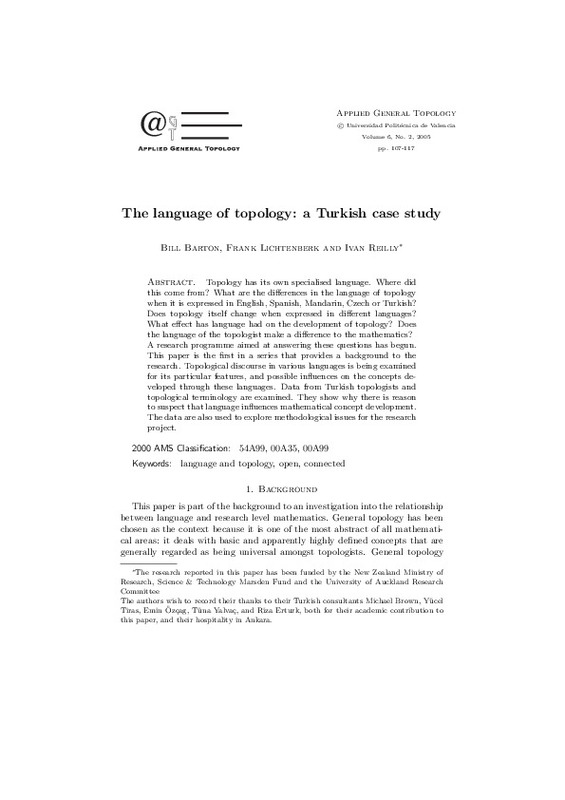JavaScript is disabled for your browser. Some features of this site may not work without it.
Buscar en RiuNet
Listar
Mi cuenta
Estadísticas
Ayuda RiuNet
Admin. UPV
The language of topology: a Turkish case study
Mostrar el registro sencillo del ítem
Ficheros en el ítem
| dc.contributor.author | Barton, Bill
|
es_ES |
| dc.contributor.author | Lichtenberk, Frank
|
es_ES |
| dc.contributor.author | Reilly, Ivan
|
es_ES |
| dc.date.accessioned | 2017-06-09T08:19:57Z | |
| dc.date.available | 2017-06-09T08:19:57Z | |
| dc.date.issued | 2005-10-01 | |
| dc.identifier.issn | 1576-9402 | |
| dc.identifier.uri | http://hdl.handle.net/10251/82629 | |
| dc.description.abstract | [EN] Topology has its own specialised language. Where did this come from? What are the differences in the language of topology when it is expressed in English, Spanish, Mandarin, Czech or Turkish? Does topology itself change when expressed in different languages? What effect has language had on the development of topology? Does the language of the topologist make a difference to the mathematics? A research programme aimed at answering these questions has begun. This paper is the first in a series that provides a background to the research. Topological discourse in various languages is being examined for its particular features, and possible influences on the concepts developed through these languages. Data from Turkish topologists and topological terminology are examined. They show why there is reason to suspect that language influences mathematical concept development. The data are also used to explore methodological issues for the research project. | es_ES |
| dc.description.sponsorship | The research reported in this paper has been funded by the New Zealand Ministry of Research, Science & Technology Marsden Fund and the University of Auckland Research Committee | |
| dc.language | Inglés | es_ES |
| dc.publisher | Universitat Politècnica de València | |
| dc.relation.ispartof | Applied General Topology | |
| dc.rights | Reconocimiento - No comercial - Sin obra derivada (by-nc-nd) | es_ES |
| dc.subject | Language and topology | es_ES |
| dc.subject | Open | es_ES |
| dc.subject | Connected | es_ES |
| dc.title | The language of topology: a Turkish case study | es_ES |
| dc.type | Artículo | es_ES |
| dc.date.updated | 2017-06-09T06:27:12Z | |
| dc.identifier.doi | 10.4995/agt.2005.1950 | |
| dc.rights.accessRights | Abierto | es_ES |
| dc.description.bibliographicCitation | Barton, B.; Lichtenberk, F.; Reilly, I. (2005). The language of topology: a Turkish case study. Applied General Topology. 6(2):107-117. https://doi.org/10.4995/agt.2005.1950 | es_ES |
| dc.description.accrualMethod | SWORD | es_ES |
| dc.relation.publisherversion | https://doi.org/10.4995/agt.2005.1950 | es_ES |
| dc.description.upvformatpinicio | 107 | es_ES |
| dc.description.upvformatpfin | 117 | es_ES |
| dc.type.version | info:eu-repo/semantics/publishedVersion | es_ES |
| dc.description.volume | 6 | |
| dc.description.issue | 2 | |
| dc.identifier.eissn | 1989-4147 | |
| dc.contributor.funder | Ministry of Science and Innovation, Nueva Zelanda | |
| dc.contributor.funder | Marsden Fund | |
| dc.contributor.funder | University of Auckland | |
| dc.description.references | B. Barton and R. Frank, Mathematical Ideas and Indigenous Languages: The extent to which culturally-specific mathematical thinking is carried through the language in which it takes place, in B. Atweh, H. Forgasz & B. Nebres (Eds) Sociocultural Research in Mathematics Education: An International Perspective, Mahwah, NJ:Lawrence Erlbaum Associates (2001), 135-149. | es_ES |
| dc.description.references | B. Barton and I. Reilly, Topological Concepts and Language: A Report of Research in Progress, Notices of the South African Mathematical Society 30(2) (1999), 110-119. | es_ES |
| dc.description.references | T. Dale and G. Cuevas, Integrating Language and Mathematics Learning, in J. Crandall (ed) ESL Through Content-Area Instruction, Englewood Cliffs, NJ: Prentice Hall Regents (1987), 9-52. | es_ES |
| dc.description.references | H. Hacisalihoglu, A. Haciyev, V. Kalantarov, A. Sabuncuoglu, L. M. Brown, E. Ibikli and S. Brown, Matematik Terimleri S¨ozl¨ug¨u, Ankara: Hacettepe University (2000). G. Lewis, The Turkish Language Reform: A Catastrophic Success, Oxford: Oxford University Press (1999). | es_ES |
| dc.description.references | S. Mardesic, Topology in Eastern Europe 1900 – 1950, Topology Proceedings 25 (2000), 397-430. | es_ES |
| dc.description.references | J. Nagata, Looking Back at Modern General Topology in the Last Century, in M. Husek & J. van Mill, Recent Progress in General Topology II, Netherlands: Elsevier Science B. V. (2002), 561-564. | es_ES |
| dc.description.references | K. H. Parshall and A. C. Rice, Mathematics Unbound: The evolution of an international mathematical research community, 1800-1945, Providence, RI: American Mathematical Society (2001). | es_ES |
| dc.description.references | R. Pinxten, I. van Dooren and F. Harvey, The Anthropology of Space: Explorations into the Natural Philosophy and Semantics of the Navajo, Philadelphia: University of Philadelphia Press (1983). | es_ES |
| dc.description.references | M. E. Rudin, Topology in the 20th Century, in M. Husek & J. van Mill, Recent Progress in General Topology II, Netherlands: Elsevier Science B. V. (2002), 565-569. | es_ES |








